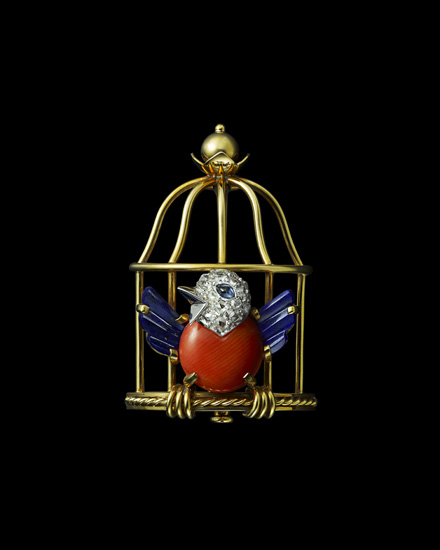
Tribute to the jewels of the resistance
At thesecond-hand commemorations of the 80th anniversary of the Liberation, 58 facettes invites you to look back at the history of certain resistance jewels to learn more about how jewelry and politics came together to denounce the horrors of the Second World War.
The Bird in a Cage Cartier, symbol of resistance
1942, the Germans occupy the capital. The officers are positioned at the Ritz, very close to the famous boutique Cartier. Jeanne Toussaint, nicknamed the Panthère, has been at the head of the artistic direction of the house for several years now. Despite the dangers and constraints of the German occupation, Jeanne Toussaint last decided to stay in Paris to lead the House Cartier. However, the threat of seeing the stock of stones and high jewelry seized by the Germans is very real. This is why, secretly, the most beautiful pieces of the house are transported to the free zone in Biarritz.
It was in this context of resistance and creativity that Jeanne Toussaint had the idea of designing for Yvonne Printemps, a French actress and singer, nicknamed the Rossignol, a jewel that would be a symbol of occupied France. It was Peter Lemarchand, one of her most talented collaborators, who was responsible for designing the jewel imagined by Jeanne Toussaint: a pendant in the shape of a cage with a bird inside, a jewel referring to both captivity and hope.
Cartier will produce two versions of the Bird in a Cage. The first, created in 1942, represents a bird locked in a cage, symbolizing occupied France and therefore the absence of freedom. The second version appears in 1944, as the liberation of Paris approaches. In this version, the bird is represented outside the cage, illustrating the newfound freedom of France.

Moreover, L'Oiseau en cage de Paris is not just a piece of jewelry remarkable for its aesthetics. The historical and symbolic meaning of this jewel is also important. Indeed, the motif of the caged bird and the freed bird has become a symbol of hope and resilience of the French people. The jewel was even worn by members of the resistance and sympathizers to discreetly show their support for the cause. Thus, L'Oiseau en cage is a remarkable illustration of how art and design can be at the service of politics and deep feelings in times of crisis. It becomes a true patriotic jewel.
This jewel, carrying a strong message of protest against the occupier, was quickly spotted by the Gestapo in the shop windows of the rue de la Paix. Mrs. Toussaint's passive resistance led to her arrest. Fortunately, she was released after three days of interrogation.
A little later, Cartier And Van Cleef & Arpels have created pins with the Freed Bird. On the pin Cartier, the colors of the French flag appear: lapis lazuli for blue, diamonds for white, coral for red. Van Cleef & Arpels brooch opts for a setting of the bird entirely in rubies and diamonds.
You can find jewelry of the same style on our site 58 Facettes
Resistance through jewelry
Also during the Nazi occupation, some individuals used symbols and personal objects to express their resistance against atrocities and injustices. The story of Françoise Leclercq is a poignant example.
In 1942, horrified by the Vel d'Hiv roundup, where thousands of Jews were arrested by the French police and then deported to Nazi concentration camps, Françoise Leclercq, a client of Cartier, decides to demonstrate its opposition to this persecution.
She then places an order at home Cartier, requesting the creation of a gold star. The gold star is a reminder of the yellow star that Jews were forced to wear. However, its gold version illustrates both solidarity with the victims and resistance to oppression. To create this star, Françoise Leclercq melted down her own religious jewelry, adding a personal and sacred dimension to the act of creation.
More than a gesture of solidarity, Françoise Leclercq's act is an act of defiance. By wearing this gold star, she openly showed her opposition to the actions of the Nazis. This example is part of a broader context where individuals used personal objects and symbols to express their resistance. Jewelry in particular was a discreet but powerful object. It allowed those who wore it to display their position in a more subtle but visible way for those who understood its meaning.
The cross of Lorraine
After the defeat of the Allied forces at Dunkirk in June 1940, General de Gaulle, refusing to capitulate to Nazi Germany, retreated to London. Welcomed at Putney Hill, he was given a vehicle and an office at the London headquarters of Cartier, located at 175 Bond Street. The house of fine jewelry Cartier then becomes a discreet but significant support for the cause of the French Resistance.In 1941, the Cross of Lorraine, with its two unequal horizontal bars, was chosen as a rallying symbol for the French Resistance. Easily identifiable, it helped unify and inspire French resistance fighters.
The workshops of Cartier in London are responsible for the creation of this medal, which adds a dimension of prestige to this symbol.